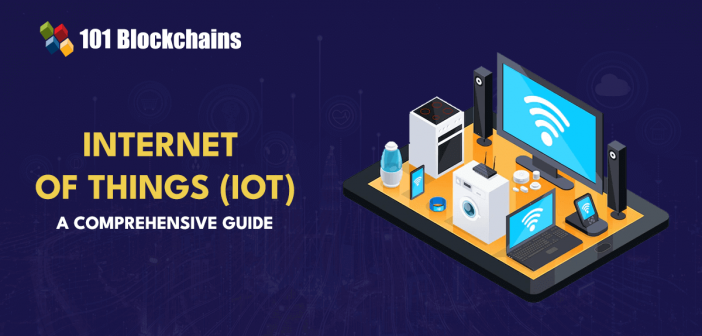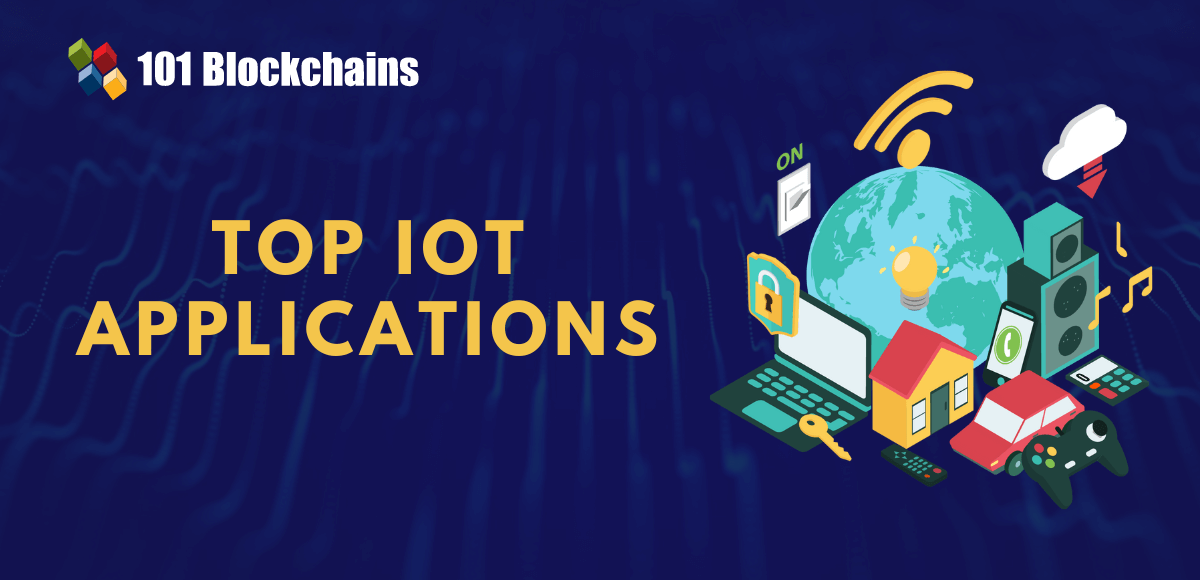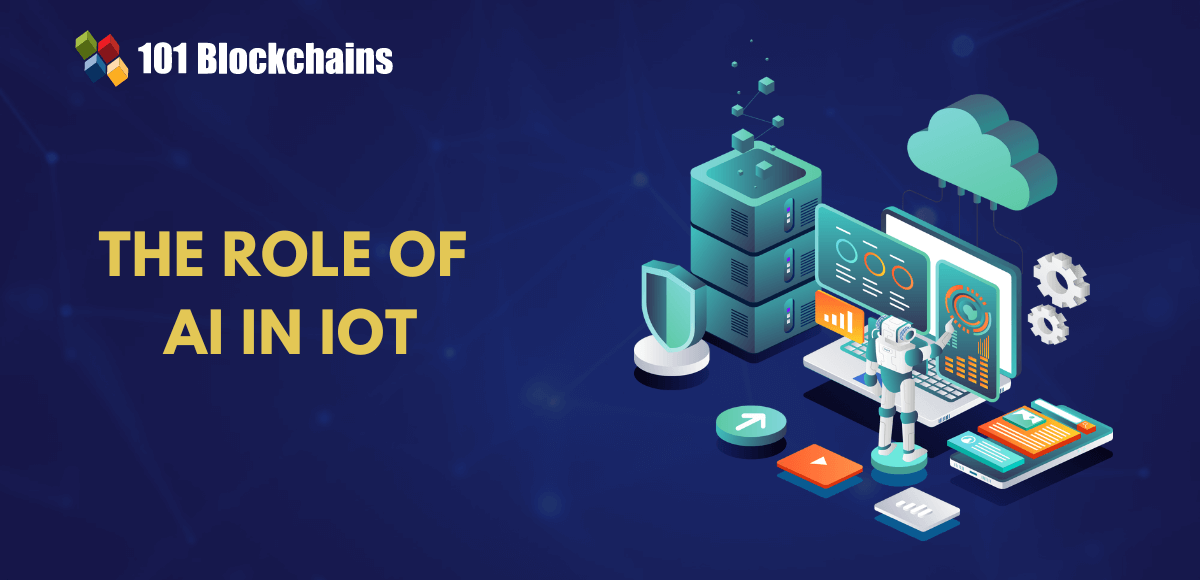Learn how blockchain truly works, master key definitions, and uncover what makes smart contracts so "smart." Dive into the fundamentals, gain valuable insights, and start your blockchain journey today!

IoT
Georgia Weston
on August 24, 2023
A Comprehensive Guide on Internet of Things (IoT)
The Internet of Things or IoT has become one of the top terms for discussion in the domain of technology. Beginners want to find a detailed introduction to Internet of Things explained in simple terms for identifying the best ways to use IoT. Internet of Things refers to a massive network of devices connected to each other, which can also interact and exchange data with each other.
From a broader perspective, IoT denotes the combination of computing, the physical world, and networks for creating interconnected and smart systems. The smart systems based on IoT have capabilities for the collection and analysis of data in real-time alongside taking relevant actions. How could IoT define the technological landscape of the future? The following post helps you find answers with a detailed introduction to Internet of Things and its components.
Where Did IoT Come From?
The introduction to Internet of Things or IoT also focuses on the starting point for IoT. Where did IoT find its origins? Before you find answers to “What is Internet of Things?” you should know that the term was introduced in 1999. A British technology pioneer, Kevin Ashton, came up with the term Internet of Things.
He had envisioned a world in which all the objects could connect to the internet and interact with each other seamlessly without human intervention. However, the IoT we witness today features a combination of different trends, such as emerging wireless technologies and introduction of low-cost microcontrollers and sensors. Furthermore, the rise of big data analytics and cloud computing also played a crucial role in expansion of the IoT landscape.
Another highlight in an Internet of Things tutorial points to the early adoption of IoT. In the initial stages, companies using IoT were primarily restricted to industrial and manufacturing settings. Industrial and manufacturing companies utilized sensors alongside other embedded devices for the automation of their operations.
In addition, the companies also leveraged IoT for optimization of their production processes. Internet of Things has become an integral part of the daily lives of people across multiple examples, such as wearable devices, smart homes, smart healthcare systems, and connected cars. IoT has played a crucial role in transforming the ways we follow for interacting with technology and each other.
Want to understand the fundamentals of the Internet of Things (IoT)? Enroll Now in IoT Fundamentals Course!
What is Internet of Things?
The next important concern in a guide to Internet of Things would point at the definition of IoT. You can understand the IoT architecture only by understanding the fundamental highlights of IoT. Internet of Things refers to physical objects equipped with sensors, processing power, software, and other technologies for connecting and transferring data with other systems and devices across the internet and other communication networks. In other words, IoT could be described as a network of interconnected devices like sensors, cameras, and electronic equipment. The devices can be programmed to ensure automation of connected devices in the IoT network.
IoT is one of the popular concepts which have gained significant popularity in the last few years. The interest in components of IoT has been growing higher as the possibilities of IoT imposing a massive impact on the future of mankind have been becoming more prominent. IoT could help people by providing more control over devices in their surroundings and the flexibility for transforming real-world objects into smart, automated virtual devices.
Expand your knowledge of IoT with comprehensive IoT Flashcards explaining IoT terms and technologies
What Will You Find in the Internet of Things Ecosystem?
The Internet of Things ecosystem includes a massive network of interconnected devices that collect, exchange, and share data on the cloud or a physical database. Beginners could find out how IoT works by reflecting on building blocks of the industry-grade IoT systems.
For example, industry-grade IoT systems feature multiple components in their architecture for different functionalities such as software, hardware, connectivity, and analytical capabilities. What are the essential components of an IoT system? The answer could vary from business to business, depending on their requirements. However, you can find some general components in an IoT infrastructure independent of the type of ecosystem.
-
IoT Devices
The first thing you need to learn about architecture of IoT would refer to devices. IoT devices are an integral component of the Internet of Things ecosystem as they serve as the foundations of the IoT network. For example, sensors work as an important tool in the IoT ecosystem for ensuring accuracy and credibility of data.
Furthermore, devices in architecture of IoT ecosystem also include microcontrollers and physical appliances associated with IoT devices. The two most common devices in IoT ecosystem include sensors and actuators. Sensors are responsible for collecting small data from surroundings of the IoT devices. Sensors can also be defined as detectors, as they can detect the slightest changes in the environment.
Actuators are also an important highlight in Internet of Things examples as they focus on taking action. It is reasonable to notice that actuators work exactly in the opposite manner of sensors. Actuators receive a command or signal and perform the relevant action. Actuators are equally important as sensors because they have to work on the trigger identified by sensors in the environment.
-
Network
The second important highlight in description of architecture of Internet of Things points to the identity of IoT as a network. From a general perspective, the IoT architecture is similar to a network of sensors, actuators, devices, and the cloud. However, all the components in the network could not deliver the desired results independently.
Therefore, all the components must interact with each other for processing data and implementing the associated actions. It is important to remember that the network layer is the second addition to the complex IoT ecosystem. The network layer features protocols and IoT gateways as the primary components.
Protocols serve as the channel between sensors and the cloud with the help of an invisible language for enabling communication between physical objects. Some of the most popular wireless IoT protocols include Wi-Fi, Bluetooth, MOTT, DDS, and others.
Another important addition among components of IoT in the network layer refers to IoT gateways. Gateways work on interpretation of network protocols alongside pre-processing the data before transferring sensor data to the cloud. As a result, the IoT gateways could ensure seamless communication across different devices within the network.
Want to familiarize yourself with the technology stack associated with IoT? Enroll Now in Internet Of Things (IoT) – Intermediate Level Course!
-
Security
The security element in an Internet of Things ecosystem points to the components for defining access control in an IoT network. In addition, the security component also addresses the need for security of data transfer, scanning for problematic software, and preventing data leakage. Furthermore, the security element in IoT also involves software and firmware from popular security providers, such as Azure Sphere.
-
IoT Gateway
IoT gateways refer to the physical devices which could transmit data from sensors to the IoT cloud and vice versa. The IoT gateways are important additions for explaining how IoT works by ensuring data preparation before transferring data to the cloud. Most important of all, IoT gateways ensure that IoT devices can connect to the internet without any intermediaries.
-
IoT Cloud
The introduction to Internet of Things explained for beginners would also shed light on the importance of IoT Cloud. Once the sensor data has been uploaded to the cloud, the network should process the data. The IoT Cloud serves as a high-performance facility for storing and managing massive volumes of data. It also serves as the primary destination for making critical decisions within milliseconds.
IoT Cloud could serve as the brains for the IoT ecosystem alongside guaranteeing massive processing capacity, storage capabilities, and networking options. In addition, the IoT Cloud also brings the value of analytics and IoT service alongside ensuring quicker availability of information to customers.
-
IoT Analytics and Data Management
The components in an Internet of Things ecosystem also draw attention to the element of IoT analytics and data management. An IoT system could make sense of the massive volumes of sensor data only by using IoT analytics. The detailed overview of an Internet of Things tutorial for beginners would help you identify how IoT analytics focuses on transforming raw data into actionable insights.
For instance, it could help in determining the KPIs for an application where you want to look for problems or inconsistencies. The utility of IoT analytics could be seen in simple examples such as detection of temperature in a room or forecast for trends in business performance.
-
User Interfaces and End-user Experiences
The final addition among the important components of IoT systems points to the user interfaces. Interestingly, the user interface is the visible component of an IoT network for users. You can access an IoT system directly from the end-user device or through internet-connected devices like laptops, tablets, and smartphones.
Users could also connect with their desired IoT devices or ‘things’ directly through the internet. For example, you can connect with smart appliances in your home through assistants such as Google Home and Amazon Alexa. Therefore, it is important to ensure that IoT user interfaces should be well-designed and user-friendly.
Curious to know how the IoT business mechanisms work? Enroll Now in the Internet Of Things Business Impact Course!
Common Examples of IoT Applications and Services
The introduction to Internet of Things also draws attention to IoT applications and services which can deliver value to users. How can devices connected to each other through the internet deliver value? You can find the answers in different industries with a wide range of opportunities and challenges. Here are some of the common examples of applications of Internet of Things.
-
Smart Homes
The most common addition among Internet of Things examples would point to smart homes. Smart devices such as cameras, smart thermostats, lighting systems, and electrical appliances could work in unison to improve living experiences. For example, the interconnectivity among appliances at home could help in offering a more secure, comfortable, and energy-efficient living experience. The appliances could use sensor data and use preferences for adjusting temperature and other settings for optimizing energy consumption.
Announcement – Certified IoT Professional (CIOTP)™ Certification Launched, Explore to develop fluency in creating ideas and application designs for IoT.
-
Smart Cities
Building upon the concept of smart homes, IoT could also play a critical role in building smart cities. Smart cities could utilize Internet of Things to improve urban infrastructure and utilities such as public safety, water supply management, and traffic management. The effective use of IoT devices could help with multiple value benefits, such as reducing congestion in traffic or optimizing routes for collection of waste.
-
Agriculture
Another popular industry that has actively embraced the applications of IoT is agriculture. The explanation for how IoT works in agriculture would point to the use of Internet of Things for livestock monitoring and precision farming. For example, Internet of Things devices could collect data regarding soil nutrient levels, temperature, and moisture. The data collected by devices could help in optimizing irrigation and fertilization strategies. IoT could also power livestock monitoring systems for tracking the location and health of animals.
-
Industrial IoT
The biggest highlight among the popular IoT applications would point to Industrial IoT or IIoT. Industrial IoT is one of the most significant examples of applications of Internet of Things. It focuses on using IoT to improve safety, efficiency, and productivity in industrial sectors.
The IIoT systems could help in monitoring performance of industrial equipment alongside identifying the need for predictive maintenance. In addition, Industrial IoT also aims at optimizing production processes by leveraging data from sensors alongside advanced analytics. As a result, Industrial IoT could help in earlier detection of signs of failure, thereby improving proactive maintenance and reduction of downtime.
Learn the latest insights about the IoT (Internet of Things) and understand how it’s related to the blockchain with industry experts with IoT Skill Path!
Conclusion
The value of Internet of Things revolves around the capability to transform gadgets and devices around us into smart appliances. For example, IoT devices such as smart refrigerators or security cameras could improve the quality of life in domestic settings. You can switch off the lights in your home remotely from your smartphone, thereby saving energy costs.
Similarly, you can keep an eye on your home while you are at the office by using smart IoT-connected cameras. The examples of IoT use cases would also point to the influence of Internet of Things on agriculture and other industries. In the long run, IoT could create an independent ecosystem of devices that run according to user preferences. Learn more about the fundamentals of Internet of Things and the reasons to use IoT for the future of technology right now.






